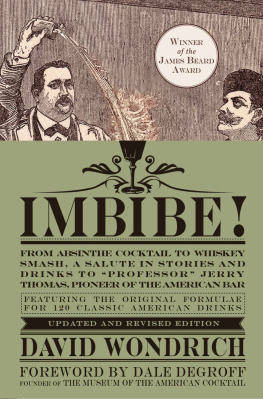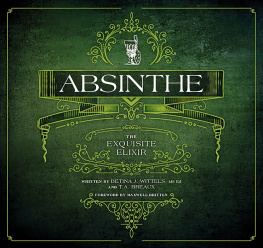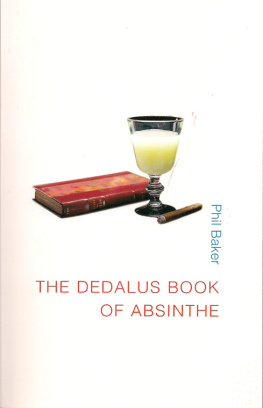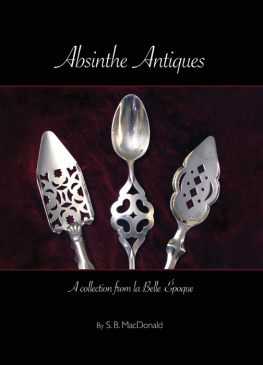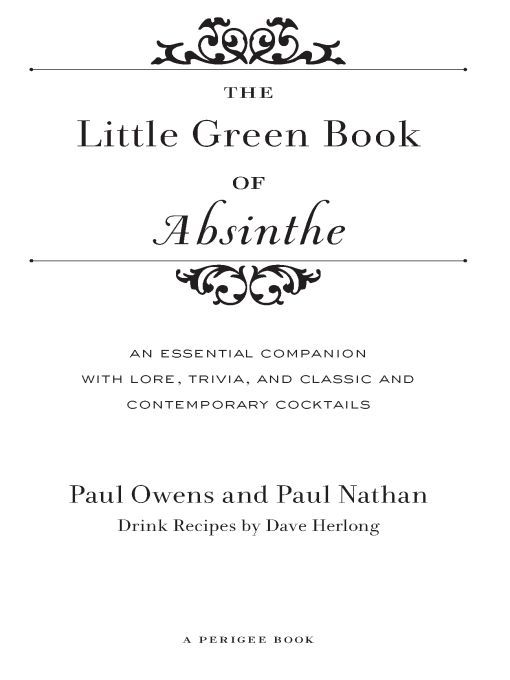Table of Contents
To the passionate and intrepid members of
the absinthe community who have so selflessly
shared their observations, preferences, and expertise.
May your sense of taste never fail.
INTRODUCTION
Absinthe means trouble. The forbidden drink. The green fairy. The absinthe murders. Muse of poets, painters, and revolutionaries. So dangerous that the United States banned it in 1912, four years before cocaine and heroin.
So naturally now that absinthe again flows unchecked in bars across the United States and Europe, Las Vegasthe original town of swagger, rebellion, and naughty weekend adventureshas adopted the spirit as its own. Vegas means trouble, and legal absinthe hit the place like three cherries on a $100 slot.
But in Vegas, where nothing stays unadulterated for long, absinthe wasnt likely to remain traditional, paired with sugar and ice water and served in an absinthe glass. In a flash of inspiration, Dave Herlong, master mixologist at the Palms Resort & Casino, began mixing it into cocktails. It was a new twist on an old idea. Absinthe began appearing in American cocktails a good forty years before the 1912 ban, most often dashed in to spice up mixed drinks. The Sazerac, Americas most famous early cocktail, was a New Orleans creation made with rye whiskey, bitters, and an absinthe rinse. By 1900, adding absinthe to mixed drinks became so common that George Kappeler, a prominent barkeep of the era, wrote, The free use of absinthe is injurious. Never serve it in any kind of drink unless called for by the customer.
It may have been uncalled for, but injurious? Plenty of experts at the timedoctors, politicians, preachersbleated about the risks of something called absinthism, akin to alcoholism but apparently more depraved. Chemists said the culprit was thujone, a neurotoxin found in grande wormwood (Artemisia absinthium, the ingredient that gives absinthe its name) that caused seizures, hallucinations, and brain damage. They were right about thujone: in high doses, its lethal. But they were wrong about absinthe. It contains very little thujone. Any danger in absinthe comes from alcohol, not poisonous plants.
Prior to 1920 the only mixers were water, tonic, and perhaps a bit of lemon during the summer. Even ice was available only in limited quantities. Drink mixers came into vogue early in the twentieth century, and bartenders began focusing as much on the mixers as on the alcohol. Gin, for instance, has lost all hints of the juniper plant for which it was named, but as it has morphed into a neutral spirit, it has become easier to mix into a wider range of cocktails.
In Vegas, Dave Herlongs innovation has been to combine the fleet of mixers we have today with moderately spiced absinthe. His first creation was a variation on the vodka-based Lemon Drop, which large parties at the Palms began ordering two and three rounds of as a shotan unheard-of order even around the high-stakes tables. Dave christened it the Gargoyle, the watcher and protector. He calls it his mother sauce, the starting point for dozens of other recipes, all included here. You can add most anything to it: fresh muddled fruits, juices, liqueurs, and other liquors. There are many others unrelated to the Gargoyle, of course: frozen drinks and hot drinks, punches and spritzers, martinis and rickeys, 117 in all. Each of the five sections contains some absolute favorites, the ones you have to try, serve, and then recommend to othersindicated with an embellishment on the recipes title.
The idea of capturing this new breed of absinthe cocktail in a book took root at parties and bars in San Francisco, including Paul Owenss restaurant, Tortilla Heights, as he and Paul Nathan watched what absinthe drinkers liked and what bartenders were experimenting with. The two of themactually the two of usmet at one of Nathans absinthe parties not long before the California Department of Alcoholic Beverage Control and local police busted him for selling absinthe. To this day, Nathan and his bartenders remain the only people arrested for selling absinthe during Americas ninety-five-year ban.
We both discovered real absinthe in the 1990s in our separate travels through Europe, and our passion for absinthe comes in large part from those experiences. But fair warning: this is not a book for purists (thankfully since neither of us can claim to be pure). We candidly and gratefully acknowledge the true history of absinthe, which in more recent times has been co-opted for dubious purposes, but at the same time we refuse to restrict ourselves to whats been done in the past. Our long-ago predecessors felt the same way, which is why we have innovations like absinthe spoons and fountains and the incredible variety of recipes from country to country that you see today, Lets broaden our horizons. The days gone by ... have gone by. The worlds most illicit spirit has been turned loose, and it shows no signs of staying in Vegas.
ABSINTHE ESSENTIALS
Absinthe ads like to trade on artists like Van Gogh and Toulouse-Lautrec, as if the history of the green fairy began in the Pigalle neighborhood of 1870s Paris, but wormwood-infused drinks have been around for thousands of years. Egyptian physicians were using them as antiseptics and cures for intestinal worms and stomachaches before King Tut. In ancient Greece, Olympic champions drank wine mixed with bitter wormwood as a reminder to remain humble in victory. And during the Middle Ages, Europeans infused beers and wines with wormwood to make health tonics.
THE ORIGINAL GREEN GODDESS
The scientific name for wormwood, Artemisia absinthium, might have come from the Greek goddess of the forest, fertility, and the hunt, Artemis, who was said to have delivered it to the centaur Chiron, a great healer, to use as medicine. Aside from using wormwood to treat cramps and certain types of disease, many cultures historically believed it could protect the genitals and promote fertility.
Until the early 1600s, Europes public houses didnt deal in spirits, only beer and wine. Liquor was primarily the domain of chemists and apothecaries. Absinthe shares those medicinal roots, despite being a relative latecomer to the bartenders shelf. As the legend goes, a French doctor, Pierre Ordinaire, invented it as a cure-all in Couvet, Switzerland, where he had fled the French Revolution in the 1780s. He was a tall, eccentric man who made his appointed rounds on an undersized horse named Roquette and experimented with a tonic of wormwood, anise, hyssop, melissa, chamomile, and other herbs steeped in alcohol. The resulting tincture became popular in the region, farm country where locals hailed it as a cure-all. Dr. Ordinaires housekeeper and lover was said to have sold his recipe for wider production after his death.
HERBS AND DISTILLATION
For all the mystique surrounding absinthe as a cultural symbol, the drink itself starts innocently enough, as a neutral spirit usually made from grapes or grains. It gets mixed with a robust blend of macerated herbs, distilled and, depending on the recipe, steeped with additional herbs to add flavor and the telltale olive green color. A second, less desirable option is to mix herbal essences and artificial flavor and coloring into an alcohol base without distillation. This is the common Czech style of manufacturing. Its less expensive, but it loses some of the nuanced flavors that come from steeping intact plants. Distillers use a range of herbs thats almost culinary (see page 34 for an extensive list of traditional ingredients).


